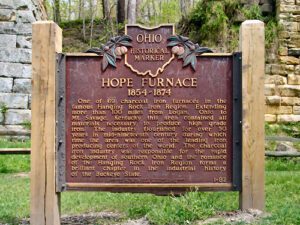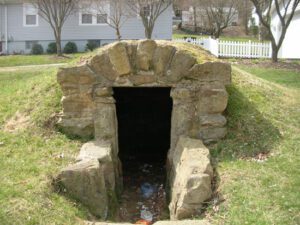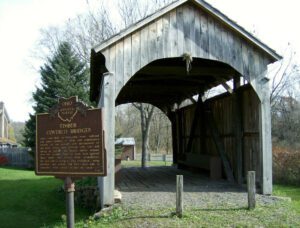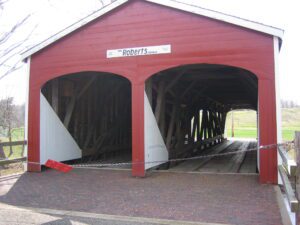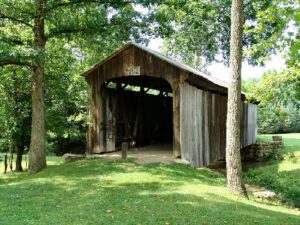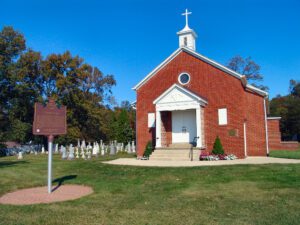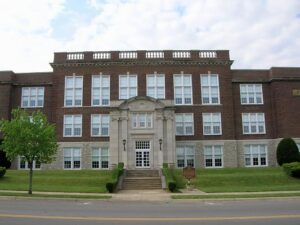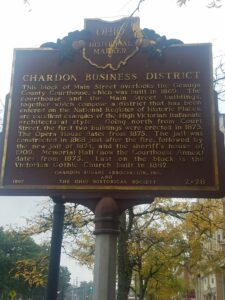, OH
One of the 69 charcoal iron furnaces in the famous Hanging Rock Iron Region. Extending more than 100 miles from Logan, Ohio to Mt. Savage, Kentucky this area contained all materials necessary to produce high grade iron. The industry flourished for over 50 years in mid-nineteenth century during which time the area was one of the leading iron producing centers of the world. The charcoal iron industry was responsible for the rapid development of southern Ohio and the romance of the Hanging Rock Iron Region forms a brilliant chapter in the industrial history of the Buckeye State.
, OH
Prisoners convicted of rioting, larceny and adultery in Morgan County between 1833 and 1839 were confined to a dungeon near the Court House in McConnelsville. This stone vault, 11 feet high, 5 feet wide and 12 feet long, was discovered in 1964 and is believed to have been used as the county dungeon. The Morgan County Pomona Grange #81 in co-operation with the County Commissioners and the County Agricultural Society reconstructed the structure on this site in 1965 as a community service project.
, OH
This covered bridge, over Middle Run, Elkrun Township, Columbiana County, is the shortest covered bridge in the United States still standing on a once-used public highway, having a clear span of 19 feet and 3 inches. It is an example, rarely found covered, of the simplest, most basic truss design, the two-panel king post truss. It has withstood the rigors of time and traffic since the 1870s and stands in eloquent testimony of the fine craftsmanship of the early Ohio bridge builders.
, OH
This covered bridge in the oldest still (1962) standing in the state and the last of the “double-barreled” spans in Ohio. It was built across Seven Mile Creek on the Old Camden Road in 1829-30 by Orlistus Roberts and J.L. Campbell. Its three burr-arch trusses built of native oak and poplar with a clear span of 73 feet, support the double roadway. This plaque has been erected to give due honor to the early timber covered bridge builders of Ohio and the important spans they constructed. [This side also contains a bridge illustration in the upper left corner]
, OH
This covered bridge, spanning Salt Creek in Perry Township, Muskingum County was erected in the 1870s. It is a splendid example of an Ohio covered bridge built with Warren type trusses. It is being preserved as an important illustration of the sound, fine craftsmanship of the early bridge builders of Ohio. This plaque has been erected to give these men the honor they greatly deserve.
, OH
This area, known as Calmoutier, was an early French Catholic farming community founded in 1832 by Claude Druhot, who came from Calmoutier, Hte-Saône, France. Its first native, the four-month-old Claude Joseph Druhot, was baptized on 9 June 1833 by Fr. John Henni, who resided at St. John’s in Canton (and in 1854 became Milwaukee’s first bishop). In 1836 Fr. John Alleman, O.P., established St. Genevieve’s Mission (when it began to keep its own records) on land donated by the Pierson and Roussel families. The log chapel that was built (the first of four churches here) predated any Catholic church building in Cleveland, Akron, and Toledo.
, OH
A focal point of community pride for generations, McClain High School was the gift of textile manufacturer Edward Lee McClain to his hometown, “as promising the greatest good to the greatest number for the longest time.” Designed by nationally prominent school architect William B. Ittner, the school was dedicated in September 1915. Lauded as one of the most complete and state-of-the-art school plants of its time, McClain High School embodied the ideals of the progressive education movement in the early 20th century. A fully equipped gymnasium, motion-picture equipment, and a pipe organ were rare luxuries for any school during this era. Additional gifts by McClain also furnished a vocational training center and an athletic field. Numerous sculptures, paintings, and other works of art displayed throughout the school continue to enhance the atmosphere of Greenfield’s acclaimed halls of learning.
, OH
This block of Main Street overlooks the Geauga County Courthouse, which was built in 1869. The courthouse and the Main Street buildings, together which compose a district that has been entered on the National Register of Historic Places, are excellent examples of the High Victorian Italianate architectural style. Going north from Court Street, the first two buildings were erected in 1873. The Opera House dates from 1875. The jail was constructed in 1868 just after the fire, followed by the new jail of 1874, and the sheriff’s house of 1909. Memorial Hall (now the Courthouse Annex) dates from 1875. Last on the block is the Victorian Gothic Church built in 1882.


